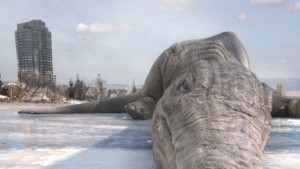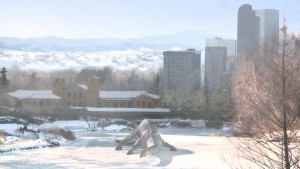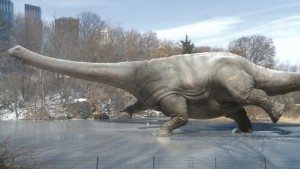Smoke & Mirrors New York (SMNY) moved into the animation realm with ‘Dinosaur’, a Denver Museum of Nature & Science spot featuring a playful brontosaurus skating around a frozen pond. fxguide talked to key SMNY artists Sean Broughton (Director/CD/Editor), Mike Donovan (Lead Sr. CG Artist), Steve Parish (Lead Sr. CG Artist/Lighting/Live Action Director) and Nic Seresin (Sr. Flame Artist) about the work.
”2010/10/09Sep/dm/denvermuseum.mp4″ “]Click here to watch the spot [31MB]
”2010/10/09Sep/dm/denvermuseum_makingof.mp4″ “]Click here to watch the making of [24MB]
fxg: How did the spot come to Smoke & Mirrors?
Broughton: We were doing a series of presentations to different agencies – just showing our wares. We got chatting to one agency, Carmichael Lynch, about R&D stuff we were working on and said we’d never really done anything like this before. Other post companies had always done dinosaurs. We’d just recently formed our 3D team at Smoke & Mirrors in New York, so we wanted to give them a product to work on.
It just so happened that Carmichael Lynch had a project that was exactly what was needed. We were then commissioned based on those conversations, which was great. Something that was going to be a test actually got commissioned and then we started working on it.
 fxg: What was involved at the beginning?
fxg: What was involved at the beginning?
Broughton: We turned ’round the spot in about a month, and that included going out and shooting it. The background elements had to look like it was the Denver Museum. We weren’t that close to Denver, obviously, so we took an HD camera and shot all the elements in Central Park. Then we had the agency commission a photographer to take stills of the area in Denver from specific camera heights, and we comped those into the background. It was real ground from Central Park but the skyline and buildings are taken from stills of the Denver area.
Those shots were tracked in 3D. The ice was completely bleached out white. As soon as you put shadows on something like that, you should be able to see details. So we had to re-create the ice field so we could re-light it for the detail. We sculpted the dinosaur from scratch. Greg Calas worked it up in…Steve, how long did it take?
Parish: He did that in about a week in zBrush as we developed our pipeline. He developed a different set of resolution maps depending on how far away the dinosaur was to camera. So for the extreme close-up shot, for example, Greg literally sculpted a new head so we could see all the detail as the dinosaur slides right into camera.
Donovan: Along those lines of incorporating new software into our pipeline, we had just gotten the release of Softimage that had ICE in it. We wanted to play a little bit with the Ice particles and also the integration of RealFlow within ICE. So we were lucky enough to get on the beta of RealFlow and test out the integration. We wanted the properties of the snow to have a very physical look to them, with real weight to them. We were able to use RealFlow which gave almost a real slush look.
 fxg: Did you storyboard or previs the spot?
fxg: Did you storyboard or previs the spot?
Broughton: Well, there was a lot of dancing going on! Rather than storyboard it, we actually went through and acted it out. We were puppeteering ourselves around the 3D floor – pretending to be dinosaurs. It was really the case of coming up with ways that a dinosaur could possibly move, even though it couldn’t really. So sitting on it’s arse and spinning across the ice having fallen over was kind of childlike thing. It happened to be the first time the dinosaur was on ice, we imagined.
It became very much of a team effort in that someone would come up with a look that worked well and everyone would jump on board that. Serkan Ertekin, our animator, recorded it and put it into his huge animation brain. So it was never really storyboarded in the traditional sense.
Parish: But we did heavily previs it. Before we went and shot anything, we did a very precise previs to get the animatic right. So we knew what shots we needed and what motion.
Donovan: We shot the whole thing in one day, basically.
Parish: In fact, the first day was slightly overcast, and that’s how we got a lot of the diffuse passes for the shadows because the frozen lake didn’t have a harsh light on it. Then on the second day we went back and shot all the prime angles.
fxg: Can you talk about modelling and rigging the dinosaur?
Donovan: We built a fairly standard base rig for the dinosaur, using forward kinematics and inverse kinematics for the legs. To maintain volume on it, we had some spring operators in there as well, say for the ribcage. We also built a secondary rig on top of that to handle the muscle jiggling. The thing that was interesting about this spot was that when we put the dinosaur in an extreme pose that it wasn’t necessarily built for, we actually ended up modelling extreme shape corrections. It was almost like giving a new base pose for the dinosaur using shape animation, and then rigging adjustments on top of that. There was a lot of blending shapes involved.
Parish: When the dinosaur actually fell down on the ground, we had his skin react to the ground.
Donovan: Yeah, we used lattice deformers to make sure there were no skin penetrations through the ground plane.
 fxg: What did you use to light and render the dino?
fxg: What did you use to light and render the dino?
Parish: The whole thing was done in Softimage XSI 7. It was actually a final gather and global illumination mental ray solution. We have a 64 bit pipeline, and at some point the displacement map was 8K at 32 bit, and it actually max’d out the RAM in our machines, and we have 12 gigs of RAM on some of them!
We also shot an HDR image on set and that was used to help in the global illumination. We had to do quite a lot of optimisation in the rendering, because the shot where he came close to camera just wouldn’t render. After we finished optimising it, we got it down to about 20 minutes a frame, which for HD we were really pleased with.
fxg: Can you go into how you did the ice effects?
Donovan: Most of the particle ice effects were done with a combination of XSI and RealFlow. What we would do is take the animation from XSI and capture it from above to find out where the dinosaur was moving. We would rip the feet off and see where they were moving. Then we would bring that it into RealFlow and create a black and white bitmap to emit particles based on where the dinosaur was moving. Then we would duplicate the feet of the dinosaur to interact with those particles inside RealFlow. Then that would be exported to Softimage through the ICE tree, and adjusted if necessary.
Parish: When it came to compositing, the contact of the feet with the ground was a big deal for us. That was Nic Seresin, who has just joined the room.
fxg: Nic, what sort of challenges did you have with the compositing?
Seresin: Well, the guys did a really good job delivering all their various passes. The tricky part was getting the dinosaur to work in the environment. So I added a lot of things like mist and breath coming out of the dinosaur to fit it in. These were real 2D elements that had been taken from our textures reels. That helped us add atmosphere. It does seem subtle, but it really helped. If you just literally place the CG dino in there and grade it, it still pings out quite a lot. We also graded the shadows to match what you could see in the back plate.
The guys delivered beauty passes, shadow passes, an edge wrap, occlusion pass – it depended on the shot. Then there were little tweaks to the colouring sometimes. We also added camera shakes when there were impacts. There were cracks added to the ice here and there, too. There was also a lot of work incorporating what was shot in New York with the stills of Denver. The Denver stuff didn’t have any snow on it, so we had to do a matte painting to add the snow. All the compositing was done in Flame.
fxg: Do you have any other comments? Is there anything you would have done differently?
Broughton: Well, if I had a chance to wear a blue leotard and do motion capture, then I might do that next time.
Seresin: I’d like to be there for that…
CREDITS
Client: Denver Museum of Nature & Science
Spot Title: Dinosaur
Air Date: June 2009
Agency: Carmichael Lynch, MN
Senior Writer: Ellie Anderson
Senior Art Director: Brad Harrison
Chief Creative Officer: Jim Nelson
Executive Integrated Producer: Brynn Hausmann
Director of Business Affairs: Vicki Oachs
Director of Integrated Production: Joe Grundhoefer
Prod Company: Smoke & Mirrors/NY
Director: Sean Broughton
Post/Effects: Smoke & Mirrors/NY
CD: Sean Broughton
Live Action Director: Steven Parish
Lead Sr. CG Artist(s): Steven Parish, Michael Donovan
Lighting: Steven Parish
Lead Animator: Serkan Ertekin
CG Artist: Wei Louie
Lead Modeler: Greg Calas
Sr. Flame Artist: Nic Seresin
EP: Celest Gilbert
Editorial: Smoke & Mirrors/NY
Editor: Sean Broughton
Telecine/Grade: Smoke & Mirrors/NY
Sound Design: Brahmstedt White Noise
Sound Designer: Carl White
Music: The Nutcracker
Composer: Tchaikovsky
Shoot Location: Central Park, New York City
